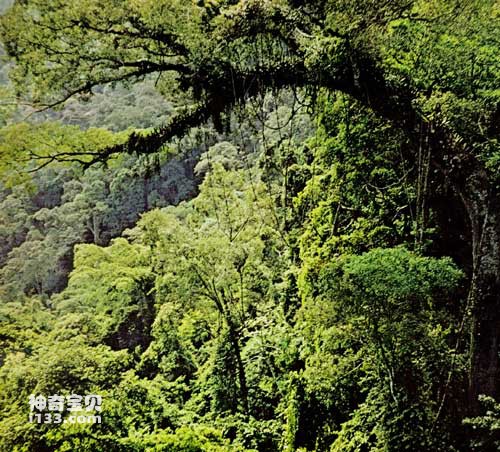We already know that the oldest groups of members of the family Hominidae known so far are basically found in the east of the African continent. But the story doesn't end there.

Early human footprints
In 1976, a research team led by Mary Leakey discovered in the volcanic ash layer deposited about 4 million years ago in the Laetoli area the footprints of members of the family that apparently walked upright on two legs, including those of adults and children. The relatively short and wide footprint.
On September 22, 1994, Tim White and other anthropologists published an article in the world's authoritative journal, the British magazine Nature, announcing that they had discovered an even earlier hominid fossil in the Afar region. The age is 4.4 million years ago. This is the earliest hominid fossil discovered so far. It is considered to be the earliest human representative to live on the open ground from the trees in the forest to the savanna, so it is named the ancestral species of Ardipithecus spp.
Precisely because the earliest members of the human family discovered so far are from eastern Africa, most anthropologists now believe that the earliest humans originated in Africa.
So, why are the earliest human fossils found in eastern Africa? What happened in Africa at that time?
Geological and paleontological research tells us that 15 million years ago, the entire Africa was covered with a vast tropical rain forest from west to east; this was a paradise for primates, inhabited by all kinds of monkeys (superfamily Macaca superfamily ) and apes (members of the family Anthropidae), and, contrary to today, there were far more apes than monkeys.

Rainforest
Later, geological movements caused changes in the environment. The crust in the eastern part of the African continent cracks along the Red Sea, Ethiopia, Kenya, Tanzania and other places, and lava from deep in the crust gushes out of the ground intermittently. The lava gushes out, cools, gushes out again, cools again... As a result, the land of Ethiopia and Kenya slowly rises, forming a broad highland with an altitude of more than 270 meters. The formation of this broad highland not only changed the landform of Africa, but also changed the climate of Africa, hindering the even flow of air from west to east that was rich in water vapor in the past. As a result, the eastern part of the highland became dry and dry due to the blocking of water vapor. areas, thereby losing the conditions for tropical rainforest growth. From then on, the continuous African rainforest (in the east) began to break up into patches of woods, interspersed with savannas and shrubs.

Savanna
Changes in the environment will inevitably make many variations that already exist in biological populations face the test of natural selection; and this mosaic ecological environment provides opportunities for the survival of multiple types of variation; however, once a certain suitable environment disappears, adaptation to The type of variation in this special environment will become extinct; and when many of these intermediate types of variation have disappeared, it is likely that some of the types that finally remain will be so different from those that originally existed that they have become New species have emerged, that is to say, biological types have been updated and organisms have evolved.
This is exactly what happened in eastern Africa around the time of human origin. As early as the 1960s, the Dutch paleoanthropologist Cortlandt had already recognized this process; after a period of neglect, in 1994, the French anthropologist Yves Coppins recognized this process again. It is what is now recognized by most scientists as the so-called "Eastern Story of the Origin of Mankind."
The beginning of the story has been explained above, and the next scene is like this.

Great Rift Valley
About 12 million years ago, continuing tectonic forces caused further changes in eastern Africa. Along the line where the earth's crust originally split, a long and curved rift valley was formed from south to north, called the "East African Rift Valley". The East African Rift Valley starts from Mozambique in the south and divides into east and west branches through Tanzania in the north; the east branch goes northeast and reaches the Red Sea through Ethiopia; the west branch goes northwest and enters Sudan through Uganda. The formation of the Great Rift Valley produced two biological effects. First, it formed an insurmountable barrier that hindered the east-west exchanges of fauna; second, it further promoted the development of a mosaic ecological environment.
It was due to this environmental force that the populations of the common ancestor of humans and modern African great apes naturally separated. The descendants of these common ancestors who stayed in western Africa still developed slowly in the direction of adapting to life in the tropical rainforest, and today have formed modern gorillas and chimpanzees; on the contrary, the descendants of these common ancestors who stayed in eastern Africa A branch of the human race, under the selective pressure of a new life on the open ground, created a new set of skills, namely bipedal upright walking and a series of adaptations brought about by it. This is human beings; at the same time, most of the Most of the African apes that once flourished 15 million years ago became extinct due to environmental changes.
Bipedal upright walking is of particularly important significance to the origin and evolution of humans. The common ancestor of humans and African great apes lived in the ancient African tropical rainforests, and therefore had already adapted to vertical movement of climbing up and down branches. They occasionally descended to the ground, but they did not walk on their knuckles like today's chimpanzees. When the East African Rift Valley was formed, the climate in eastern Africa became arid and the tropical rainforests were replaced by vast mosaics of savannas. Our ancestors did not fully adapt to all these changes at once. They still had to eat and sleep in the woods, and they still relied on the woods for most of their food (such as fruits from fruit trees). However, the environment of the savanna no longer allows them to climb up and down the big trees that have always been in the forest as in the past. They need to frequently move from one grove to another. The transfer must pass through the ground, which increases the requirements for effective ground operations. Since our ancestors have long adapted to the vertical movement of climbing up and down trees, the irreversibility of evolution determines that they cannot walk and run on four legs like cats, dogs, cows, and sheep after descending to the ground. At that time, bipedal walking became the most effective way of locomotion, and its superiority was obviously far greater than that of chimpanzees walking on their knuckles.
As you can imagine, our ancestors must have staggered and stumbled when they first descended to the ground. The acquisition of bipedal upright walking skills also developed step by step. From the discovered fossils, we know that although Ardipithecus and Australopithecus have not yet reached the level of perfection that we humans have today, they are already able to walk on two legs fairly well.
animal tags: Ardipithecus fossil
We created this article in conjunction with AI technology, then made sure it was fact-checked and edited by a Animals Top editor.